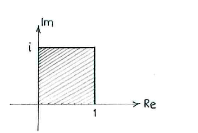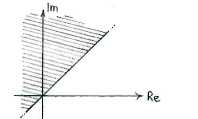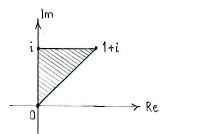Solution 3.2:2b
From Förberedande kurs i matematik 2
(Difference between revisions)
(Ny sida: {{NAVCONTENT_START}} <center> Bild:3_2_2b-1(2).gif </center> {{NAVCONTENT_STOP}} {{NAVCONTENT_START}} <center> Bild:3_2_2b-2(2).gif </center> {{NAVCONTENT_STOP}}) |
m |
||
| (5 intermediate revisions not shown.) | |||
| Line 1: | Line 1: | ||
| - | {{ | + | The inequality <math>0\leq \mathop{\rm Re} z \leq \mathop{\rm Im} z \leq 1</math> is actually several inequalities: |
| - | < | + | |
| - | { | + | :*<math>0 \leq \mathop{\rm Re} z \leq 1\,</math>, |
| - | { | + | :*<math>0 \leq \mathop{\rm Im}z \leq 1\,</math>, |
| - | < | + | :*<math>\mathop{\rm Re}z \leq \mathop{\rm Im}z\,\textrm{.}</math> |
| - | + | ||
| + | The first two inequalities in this list define the unit square in the complex number plane. | ||
| + | |||
| + | [[Image:3_2_2_b1.gif|center]] | ||
| + | |||
| + | The last inequality says that the real part of <math>z</math> should be less than or equal to the imaginary part of <math>z</math>, i.e. <math>z</math> should lie to the left of the line <math>y=x</math> if <math>x=\mathop{\rm Re} z</math> and <math>y = \mathop{\rm Im} z</math>. | ||
| + | |||
| + | [[Image:3_2_2_b2.gif|center]] | ||
| + | |||
| + | All together, the inequalities define the region which the unit square and the half-plane have in common: a triangle with corner points at <math>0</math>, <math>i</math> and <math>1+i</math>. | ||
| + | |||
| + | [[Image:3_2_2_b3.gif|center]] | ||
Current revision
The inequality \displaystyle 0\leq \mathop{\rm Re} z \leq \mathop{\rm Im} z \leq 1 is actually several inequalities:
- \displaystyle 0 \leq \mathop{\rm Re} z \leq 1\,,
- \displaystyle 0 \leq \mathop{\rm Im}z \leq 1\,,
- \displaystyle \mathop{\rm Re}z \leq \mathop{\rm Im}z\,\textrm{.}
The first two inequalities in this list define the unit square in the complex number plane.
The last inequality says that the real part of \displaystyle z should be less than or equal to the imaginary part of \displaystyle z, i.e. \displaystyle z should lie to the left of the line \displaystyle y=x if \displaystyle x=\mathop{\rm Re} z and \displaystyle y = \mathop{\rm Im} z.
All together, the inequalities define the region which the unit square and the half-plane have in common: a triangle with corner points at \displaystyle 0, \displaystyle i and \displaystyle 1+i.



